
Rowan County is a county in the U.S. state of North Carolina that was formed in 1753, as part of the British Province of North Carolina. It was originally a vast territory with unlimited western boundaries, but its size was reduced to 524 sq mi after several counties were formed from Rowan County in the 18th and 19th centuries. As of the 2020 census, its population was 146,875. Its county seat, Salisbury, is the oldest continuously populated European-American town in the western half of North Carolina. Rowan County is located northeast of Charlotte, and is considered part of the Charlotte Metropolitan Area.

Iredell County is a county located in the U.S. state of North Carolina. As of the 2020 census, the population was 186,693. Its county seat is Statesville, and its largest town is Mooresville. The county was formed in 1788, subtracted from Rowan County. It is named for James Iredell, one of the first justices of the Supreme Court of the United States. Iredell County is included in the Charlotte–Concord–Gastonia, NC–SC Metropolitan Statistical Area, as defined in 2013 by the Office of Management and Budget with data from the U.S. Census Bureau.

Union Grove Township is a rural, non-functioning county subdivision established in 1868 in Iredell County, North Carolina, United States. Two towns have existed in Union Grove township: 1) the unincorporated community Union Grove, established in 1857 and 2) the former town of Williamsburg established in 1812. The Union Grove Post Office was established in 1857. In 2019, within the unincorporated town of Union Grove is the Union Grove Milling Company, Union Grove School, Union Grove Volunteer Fire House, and two Methodist churches. In the later half of the 20th century, Union Grove was famous for the Fiddler's Convention which was held in Union Grove from the 1920s to 1970s. The Fiddler's Convention was originally established to benefit the Union Grove school.

Samuel Sloan was a Philadelphia-based architect and best-selling author of architecture books in the mid-19th century. He specialized in Italianate villas and country houses, churches, and institutional buildings. His most famous building—the octagonal mansion "Longwood" in Natchez, Mississippi—is unfinished; construction was abandoned during the American Civil War.

James Graham Ramsay was a North Carolina physician and politician who served in the North Carolina Senate and Confederate States Congress during the American Civil War.

Scotch Irish Township is one of fourteen townships in Rowan County, North Carolina, United States. The township had a population of 1,820 according to the 2010 census. By the requirements of the North Carolina Constitution of 1868, all counties in North Carolina were divided into townships.
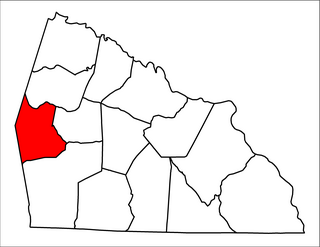
Mount Ulla Township is one of fourteen townships in Rowan County, North Carolina, United States. It is currently the smallest township in Rowan County by population.
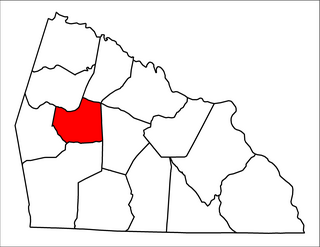
Steele Township is one of fourteen townships in Rowan County, North Carolina, United States. The township had a population of 1,725 according to the 2010 census.

Unity Township is one of fourteen townships in Rowan County, North Carolina, United States. The township had a population of 2,215 according to the 2010 census.

Cleveland Township is one of fourteen non-functioning county subdivisions (townships) in Rowan County, North Carolina that were established in 1868. The township had a population of 2,817 according to the 2010 census. The only incorporated municipality in Cleveland Township is the town of Cleveland. Residents are served by the Rowan–Salisbury School System and the township is home to Mt Ulla Elementary School.
Lancaster is an unincorporated community in Lancaster Township, Jefferson County, Indiana.

Bethesda Presbyterian Church, Session House and Cemetery is a historic Presbyterian church, session house, and cemetery located in Chambersburg Township, Iredell County, North Carolina. It was built in 1853, and is a one-story, three bay by five bay, rectangular vernacular Greek Revival style frame church. It has a pedimented, temple form, front gable roof and an unusual front recessed balcony. It is the oldest church building in Iredell County. Also on the property is the contributing session house, also built in 1853, and church cemetery with about 200 gravestones.
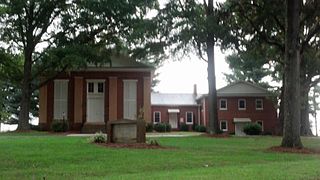
Back Creek Presbyterian Church and Cemetery is a historic Presbyterian church and cemetery in Mount Ulla Township, Rowan County, North Carolina currently affiliated with the Presbyterian Church in America (PCA). It was named for a nearby stream, which was back of Sills Creek and called Back Creek.
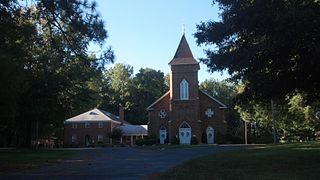
Thyatira Presbyterian Church, Cemetery, and Manse is a historic church at 220 White Road off NC 150 in Mill Bridge in Rowan County, North Carolina, ten miles west of the town of Salisbury. Presbyterians have been worshiping at this site since at least 1753.
Mount Vernon is a historic plantation house, farm complex, and national historic district located near Woodleaf, in Scotch Irish Township, Rowan County, North Carolina. The house was built about 1822, and is a two-story, three bay, Federal style frame dwelling. It is sheathed in weatherboard and has a full-width, one-story shed roofed porch. The house was designated a post office in 1822. Also on the property are the contributing log smokehouse, large barn, "lighthouse" or Delco house, corn crib, gear house, woodhouse, spring house, mill site, shop, and plantation office.
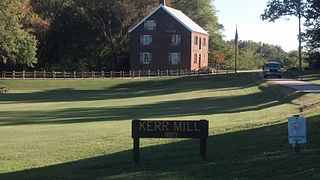
Kerr Mill is a historic grist mill building located near Mill Bridge, Steele Township, Rowan County, North Carolina. It was constructed in 1823 by Joseph Kerr, a large plantation owner. The mill is a brick building with two-stories and three bay by two bay. It rests on a stone foundation and has a gable roof. The mill was operated commercially until the 1940s and has since been refurbished as part of Sloan Park run by Rowan County. The mill and surrounding property are operated by Rowan County as Sloan Park.
Francis Locke Sr. (1722–1796) was a plantation owner, businessman, politician, and a participant in the American War of Independence, where he led the American Patriots to the decisive victory at Ramseur's Mill, which turned the tide of the American War for Independence in the south.

Chambersburg Township is a township in Iredell County, North Carolina, United States. The 2010 United States Census reported a total population of 11,344.
James Brandon (1734–1790) was an early pioneer in Rowan County, North Carolina and an officer in the North Carolina militia during the American Revolution. He commanded the 2nd Rowan County Regiment from 1782-1783.
Thomas Gillespie was a large plantation owner in mid-to-late 18th-century North Carolina and served as commissary of the Rowan County Regiment in the North Carolina militia during the American Revolution. He spent his early life in Augusta County, Virginia before migrating to Anson County, North Carolina in about 1750, where he lived most of his life on Sills Creek in the area that became Rowan County, North Carolina in 1753. He and his wife and son were the first white settlers west of the Yadkin River. He owned a plantation of over 1,000 acres on Sills Creek in Rowan County, as well as 6,000 acres in the area of western North Carolina that became part of the state of Tennessee in 1796. He was an early elder in the Thyatira Presbyterian Church in Rowan County, which was formed in 1753. Thomas was the great-grandfather of U.S. President James K. Polk through the lineage of his daughter Lydia, who married Captain James Knox and gave birth to Jane Gracey Knox, mother of the President.















